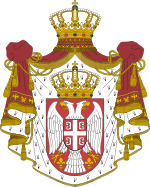Serbian_National_Council_for_Kosovo_and_Metohija
The Politics of Serbia are defined by a unitary parliamentary framework that is defined by the Constitution of Serbia in which the president, currently Aleksandar Vučić, is the head of state while the prime minister, currently Ana Brnabić, is the head of government. Executive power is exercised by the Serbian government and the President of Serbia. Legislative power is vested in the unicameral National Assembly which is composed of 250 proportionally elected deputies. The judiciary is independent and is headed by the Supreme Court of Cassation, which is also the highest court in Serbia.
The Serbian political system uses a multi-party system. The first political parties and organizations were established in the first half of the 19th century but they were officially registered as political parties in 1881. The People's Radical Party (NRS) dominated Serbian and Yugoslav politics from the late 1880s until 1928. Serbia was a part of the Kingdom of Serbs, Croats and Slovenes (later known as the Kingdom of Yugoslavia) from 1918 until 1941. During the period of German occupation the government was independent and was mostly run by military personnel, right-wing politicians and former members of the fascist Yugoslav National Movement (ZBOR). After World War II, Serbia was re-established as a one-party state and as one of the constituent republics of the communist Yugoslavia, which was headed by the League of Communists of Serbia (SKS).[lower-alpha 1] After the dissolution of SFR Yugoslavia in 1992, Serbia became a part of the Federal Republic of Yugoslavia and until 2000, it was under the dominant rule of the Socialist Party of Serbia (SPS). Since 2012, the populist Serbian Progressive Party (SNS) has been the ruling party of Serbia and it established dominant power in Serbian politics including shifting to authoritarianism, and the repression of the Serbian opposition.
The President of the Republic besides being the head of state is also the commander in chief of the Serbian armed forces and is directly elected based on popular vote to serve a five-year term, but constitutionally the president has little governing power and is primarily a ceremonial position. The current president Aleksandar Vučić serves de facto under a semi-presidential system. The government which is headed by the prime minister and currently has four deputy prime ministers in total including the first deputy prime minister position which is currently occupied by Ivica Dačić. The unicameral National Assembly has 250 seats in total and the members of the parliament are elected by popular vote to serve four-year terms. A party must receive at least 3% of the popular vote in the entire country to qualify for any seats, except the minority parties who only have to reach 0.4% of the popular vote. The ruling SNS-led coalition has 106 seats in the parliament, while the government parties in total have 155 seats which leaves the opposition with 90 seats. Besides the parliamentary and presidential elections, Serbia also holds local, regional elections and provincial elections.
Serbian Progressive Party (SNS) won in the 2014 election and the leader of SNS Aleksandar Vučić became prime minister. Three years later he moved to the presidency. Ana Brnabic has been prime minister since 2017, but president Vučić has kept a firm hold on executive power.[1]
In June 2020, Serbia's ruling Progressive Party (SNS) won a landslide victory in parliamentary elections. Main opposition groups boycotted the vote. According to the opposition the conditions were not free and fair.[2] The Economist Intelligence Unit rated Serbia a "flawed democracy" in 2022.[3]
In April 2022, President Aleksandar Vučić was re-elected, and SNS-led coalition maintained parliamentary plurality, but no longer has the majority on its own.[4] Third cabinet of Ana Brnabić was formed on 26 October 2022, and contains 29 members, including ministers without portfolio, deputy prime ministers, and the prime minister. [5] In December 2023, ruling Serbian Progressive Party (SNS) of President Vucic won a snap parliamentary election, gaining an absolute majority with more than half of the 250 seats in the National Assembly.[6]
